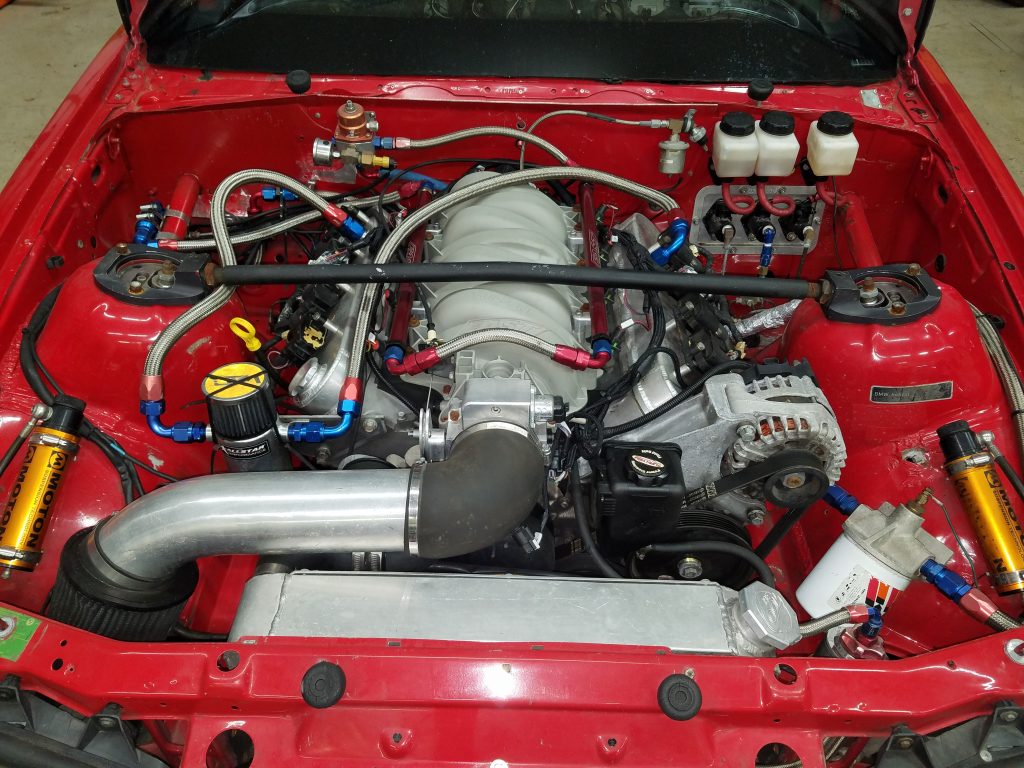
This piece was inspired by the news that a friend’s garage just welcomed another tenant. It’s a 1995 BMW E36 M3 with a 550 hp LS3 383 c.i.d. stroker where the original straight six used to be. It was built for racing.
The car is impressively detailed. It was obviously created without compromise, just another example of how engine swaps can breathe new life into a vehicle that’s either dull, dying or dead. Can’t wait to see it on the track soon.
Swapping is good. And while most automotive swaps concern engines, there are other systems and hardware (suspension, brakes, steering, transmissions, rear ends, etc.) that are exchanged in order to improve a car or truck.
The first ‘modern’ engine that inspired re-purposing other vehicles was the Ford Flathead V8, introduced in 1932 and manufactured through 1953, when overhead valve engines became the industry standard. Many a young man became a hot rodder or racer thanks to the flathead’s existence.

Perhaps the most famous example of how component swapping could revolutionize a marque is the Shelby Cobra, which started out in 1953 as the British-build Bristol AC. In 1961 Carroll Shelby had the company modify the Bristol to accept a small block (221 c.i.d.) Ford V8 to replace the stock 2.0-liter straight six. Three years later the cars were powered by the new 289 and battling Ferrari for the FIA GT championship. Then came the 427 Cobra and Daytona coupe. History was made, careers were launched and a new era in motorsports was ushered in because Carroll Shelby had a great idea.
(Note: In 1964 Shelby applied the swap concept to the Sunbeam Alpine, another small, two-seat British sports car. The 289 Ford-powered Sunbeam Tiger, built by Jensen with a royalty paid to Shelby was a hit for a few years, until the company was bought by Chrysler.)
American manufacturers caught on quickly when the muscle car craze hit. Compacts and mid-size sedans had bigger engines installed at the factory to create new flagship models that conveyed speed and performance. Plain jane Mopar products became Barracudas, Challengers, Road Runners and Super Bees. The intermediate Pontiac Le Mans spawned the famous GTO, the Chevy Chevelle hatched the Super Sport, and all the other GM divisions took a swing at hitting a sales home run as well. Ford played the game too.
Personally speaking, this writer has also been involved in a couple of engine swaps. When I totaled my father’s Plymouth Valiant (my fault, high school stupidity) I had to help him pull the 170-inch slant six from the wreck and take it over to his friend’s house where we went about installing it in his old surplus Army Jeep.
My 1968 Datsun 2000 Roadster needed a new engine after the cam chain broke while running at high RPM. It was 1981 and there simply were no engines or parts left for me, as they only made 1000 to make them legal for SCCA racing. I found out a modern L-series engine would mate to the roadster’s 5-speed tranny if I could find an early 240Z bellhousing – which I did. That swap let me drive the car another three years.
And when I learned my old ’64 Ford ½ ton truck was going to be used to pull a horse trailer I replaced the 223-inch six and 3-speed transmission with a 351 Windsor and C6 automatic. That swap gave me another 10 years of service and we won’t talk about the gas mileage.
It’s probably clear how much we love and appreciate the concept of swapping. With apologies to word purists, ‘swapping’ is one of the evolutionary concepts behind Attesa.
Our master-planned community near Casa Grande, founded upon a motorsports technology core, is going to promote innovation and thought leadership. Like how to make good things better and switching out concepts and components to create something more ‘new’ than just improved.
Attesa is being built as a world-class center for advanced transportation design. We’ll have industrial parks where engineers, scientists and fabricators can come up with new solutions plus a road race circuit for real-world testing, to prove or disprove their theories.
So yes, Attesa is going to be sort of a futuristic swap shop. For cars, trucks, motorcycles and just about anything else with wheels, powered by whatever invention turns out to be most efficient in every area possible. And then, the one after that.
